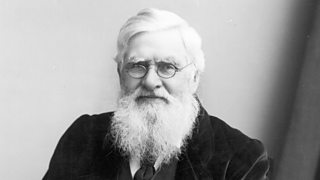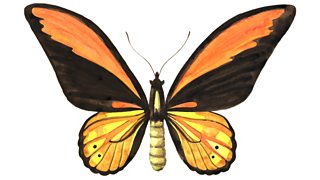Explain How The Distribution Of Animals Supported Wallace's Evolution Theory?
Evolution
Evolution by natural pick was proposed as a theory by Darwin and Wallace. What evidence is at that place in the world today to suggest that species evolve by this machinery?
Darwin and Wallace
Alfred Russel Wallace was a naturalist who independently proposed the theory of evolution by natural option. A great admirer of Charles Darwin, Wallace produced scientific journals with Darwin in 1858, which prompted Darwin to publish On the Origin of Species the following year.


Wallace worked around the world gathering evidence to support his evolutionary theory. He is best known for studying alarm colouration in animals, 1 example beingness the gold birdwing butterfly ( Ornithoptera croesus ), as well every bit his theory of speciation .
After a variety of zoological discoveries, Wallace proposed a theory of evolution which matched the unpublished ideas Darwin had kept secret for virtually xx years. This encouraged Darwin to collect his scientific ideas and collaborate with Wallace. They published their scientific ideas jointly in 1858.
Principles of evolution by natural selection
The idea behind the theory of evolution through the process of natural option is that all species of living things accept evolved from simple life forms over a catamenia of time. The Earth is about four.5 billion years old, and there is scientific show to suggest that life on Earth began more than than iii billion years ago.
Natural selection
The accepted theory of evolution explains that information technology happens by natural choice . The key points are given below.
- Individuals in a species prove a wide range of variation and this variation is a upshot of differences in their genes caused by random mutations that can be inherited.
- In every population more offspring are produced than can survive. This overproduction leads to competition, eg for food.
- Individuals with characteristics most suited to their environment are more likely to survive and reproduce. This is commonly known as survival of the fittest . The genes that allow these individuals to be successful within their surround are passed on to their offspring, which results in these specific genes becoming more than common.
- Individuals that are poorly adapted to their environment are less likely to survive and reproduce. Their genes are less likely to exist passed on to the next generation.
- Over a period of fourth dimension, a species will gradually evolve.
- Both genes and the environment tin can cause variation, only only genetic variation can be passed on to the next generation.
- If 2 populations of one species become increasingly different in phenotype that they tin no longer interbreed to form fertile offspring, this can outcome in the germination of two species.
Modelling natural selection
This model can be used to demonstrate how natural selection can occur based on the characteristic of camouflage in a population of casualty organisms.
Method
- Use a piece of green card equally a background.
- Randomly place twenty light-green and 20 white pieces of string on the card to represent populations of prey organisms.
- Using a forceps to represent the oral cavity of the predator, collect every bit many pieces of cord as yous can in ten seconds.
- Count how many green and white pieces are left and tape.
- Repeat the process twice more.
Results of the model
This model shows that even though both species of prey are predated, the species with the highest caste of camouflage tin can survive. In reality, these organisms would be able to breed and pass on their camouflage genes. Where in that location was once an fifty-fifty distribution of dark-green and white organisms, at present the camouflaged organisms outnumber the non-camouflaged organisms by 10 to 1.
Limitations of the model
In this model the casualty do non move. What if the white organisms were much faster than the light-green ones?
There may also be bias in the instance of the predator. The scientist selecting the prey may do so not on the basis that some are easier to see, merely on the basis that they were enlightened of what the results should be.
Source: https://www.bbc.co.uk/bitesize/guides/zwvpsg8/revision/1
Posted by: yudeppoccanot85.blogspot.com

0 Response to "Explain How The Distribution Of Animals Supported Wallace's Evolution Theory?"
Post a Comment